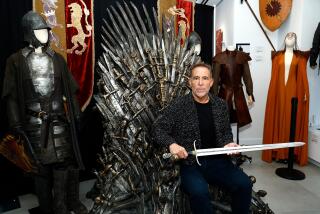Furniture That Made a Big Impression
Are you dreaming of a spectacular bedroom filled with huge, carved furniture of past centuries? Last month, Great Gatsbyâs, an Atlanta auction house, sold a four-piece set made by Italian craftsman Luigi Frullini that would fit the dream.
Frullini exhibited furniture at the Great International Exhibitions in London, Paris and Vienna. In 1896, he went to the United States to exhibit more of his furniture at the Centennial Exhibition in Philadelphia. His works were inspired by the carved pieces of the Italian Renaissance. His elaborate pieces set the fashion for the last years of the 19th century.
He created many wooden cabinets and beds with three-dimensional carvings of people, animals and flowers. The pieces by Frullini were made by carving into a large block of wood; he did not apply small carved pieces to a large board.
To accommodate all the carved decorations, he made huge pieces. The headboard of the bed was usually more than 8 feet tall by 6 feet wide. The armoire was almost 11 feet high. It was not furniture for the average bedroom, but it was suited to the huge homes of millionaires.
*
Question: I just saw a saxophone that seems to play like a player piano. I was told other instruments were also made to operate with rolls, like a player piano. What can you tell me about these automatic instruments?
*
Answer: Player musical instruments are known as organettes. They were handcrafted and made music with wind pressure acting on organ reeds. The air was forced through perforated cardboard disks or paper rolls. They were popular in the 1880s and were still being made in the 1930s. We have seen violins, harmonicas, accordions and clarinets.
*
Q Why do pieces of English silver always have a hallmark, but only some American pieces are marked?
*
A There is one very good reason: British law. Since the late 1700s, English silversmiths have been required to register their marks with the British government. So English silver is marked to show who made the silver.
American silversmiths were not required to mark their pieces, but many early-American silversmiths used hallmarks similar to the English marks.
American silversmiths hoped the English-type marks would help them sell more silver, since English silver was thought to be superior.
*
Q I have two $25 savings bonds, one dated December 1943, the other December 1944. They read, âWar Savings Bond, Series Eâ on the bottom left, and near the top are the words, âTen years from the issue date hereof will pay twenty-five dollars.â My local bank told me the bonds are now worth about $100. Would they be worth more to a collector?
*
A Series E bonds issued from May 1941 through February 1960 no longer earn interest. Your bonds did earn interest for 40 years.
It is doubtful that a collector would pay more for your bonds than they are worth if cashed in. You can also exchange them for new U.S. savings bonds.
*
Q My father collects old medicine and bitters bottles. Now he has started buying old food jars. He just paid $25 for a 5 1/4-inch clear glass jar with diagonal ribs all around and an elephant head embossed on the side. The word âJumboâ is above the elephant. Under it are the words âPeanut Butter.â Embossed on the bottom of the jar is the phrase âAll the children like Jumbo,â along with the number 81439 and the date, âJune 24, 1930.â There is no top or label on the jar. Can you tell us anything about the brand?
*
A Jumbo brand peanut butter was made by the Frank Tea & Spice Co. of Cincinnati from the early 1930s to 1967. The brand was named after the famous P.T. Barnum circus elephant. Over the years, Jumbo brand peanut butter was sold in a variety of glass jars. Some had paper labels.
Your fatherâs jar, with embossed ribs down the length of the jar and the patent number and date on the bottom, is an early one. Jumbo brand jars without labels and tops are not hard to find. Old ones with paper labels and original lithographed tin lids are scarce.
For a listing of helpful books and publications, include a self-addressed, stamped (55 cents) envelope to Kovels, Los Angeles Times, King Features Syndicate, 235 E. 45th St., New York, NY 10017.
(BEGIN TEXT OF INFOBOX / INFOGRAPHIC)
Current Prices
Figures are recorded from antique shows, flea markets, sales and auctions throughout the United States. Prices vary because of local economic conditions.
* Baseball glove, Willie âPuddinâ Headâ Jones model, Rawlings, 1940s, $45.
* Prudential Insurance 1915 calendar, lovely woman, Warde Traver, 11 1/4 by 7 1/4 inches, $55.
* Curiosity Shop lunch box, metal, King Seeley Thermos, 1972, $60.
* Canton dish, sailboats, willows, buildings, 8 sides, dash border, circa 1780, 10 inches, $140.
* Bronze chauffeur badge, Arizona, 1933, 1 3/4 by 1 inches, $105.
* Effanbee dummy, Charlie McCarthy, composition socket head, muslin body, 1937, $625.
* Carnival-glass plate, wishbone and spades pattern, black amethyst, 6 inches, $1,000.
* Firefighting bucket, leather, âAlways Ready,â S. Willard Orford, New England, 1840, 12 inches, $1,320.
* Knoll conference table, teak, elliptical, chromed-steel pedestal base, 1961, 96 inches, $2,195.
* Howe Machine Co. bicycle, Huntington leatherwork, green finish, gilt, 1880, 52 inches, $4,025.


